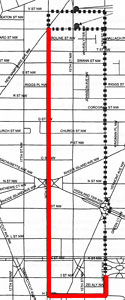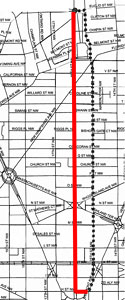WMATA lays out choices for new 16th Street bus route
WMATA is considering 2 options to add more rush hour service to the 16th Street bus line near downtown. One option would start at either U Street or V Street, and the other would extend up Meridian Hill to Euclid Street.
The 16th Street buses are overcrowded along the southern part of the S-series Metrobus line in the morning rush. Riders hoping to catch a bus south of Columbia Heights frequently watch one bus after another pass by without stopping, too full to take on any new passengers.
WMATA head bus planner Jim Hamre and his team presented the new route options at a meeting last night organized by Dupont ANC commissioner Kishan Putta.
Both options begin around Meridian Hill, serve all bus stops along 16th Street from there to Lafayette Park, and then run back north without stopping, in order to start over as quickly as possible.
Frequency versus coverage
WMATA only has 2 buses available to run this service, so the options present a choice of high frequency versus greater coverage.
The first option, on the left, is the easiest to operate and provides the greatest frequency. Buses in the morning rush hour would come every 15 minutes, in addition to the existing bus service. But the line would end at either U or V Street, and the crowding problems start farther north.
The second option, on the right, extends up Meridian Hill to Euclid Street. This would reach more passengers, but adds time and complication. Buses would only be able to run every 20 minutes at best. They would also get delayed more often because the streets around Meridian Hill are only a single lane and are often blocked by other vehicles.
Another potential complication for the second option is how buses would get back north. While northbound buses for the U/V Street option could use 14th Street, the only way to keep even 20 minute headways for the Euclid Street option would be to run northbound using 15th Street. 15th Street doesn’t currently have any buses, so residents there may have concerns.
Interestingly, Hamre said the worst crowding problems only appear during the morning rush, so this new supplement may only run in the morning. Evening rush hour buses are crowded too, but less excessively so. Riders aren’t usually being left behind in the evening.
There was widespread consensus at the meeting to support a rush hour supplement, but residents disagreed over which option is better. Eventually WMATA may be able to add service farther north and still provide good frequencies, but they’ll need more buses and more money to do it. In the meantime, they have to make do with only 2 buses, which means trade-offs.
Either way, riders on 16th Street should benefit. Even those from farther north should see improved service, since the buses they’re already on will move faster near downtown.
Theoretically the new route will be called the S3, although Hamre didn’t commit to that last night.
If everything goes smoothly, the new buses could roll down 16th Street as early as March 24. If there are delays then it could take longer.
Ultimately, Hamre said, WMATA also hopes to start “headway scheduling” on 16th Street. That means they would try to keep buses a certain distance apart rather than meet a predefined schedule. That works for Circulator buses, and for the 70s and 90s series Metrobuses, but it will take longer to implement, and is being considered a separate issue.
 Cross-posted at BeyondDC.
Cross-posted at BeyondDC.


